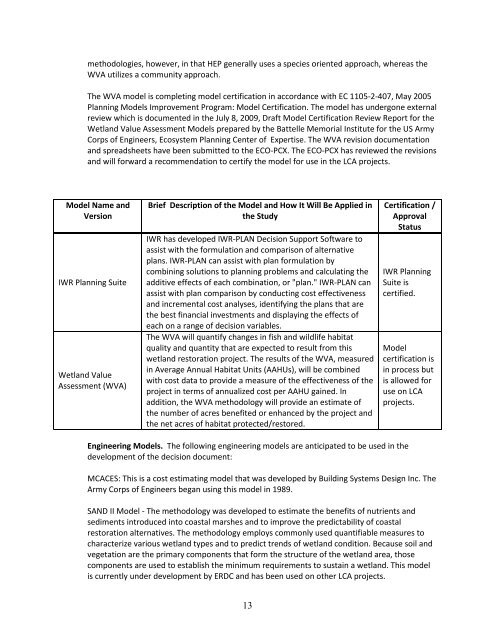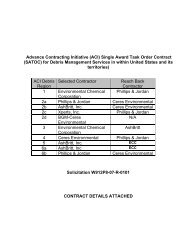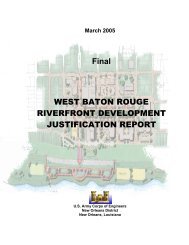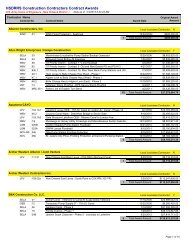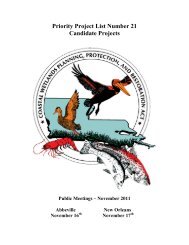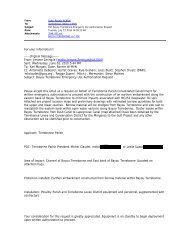LCA Myrtle Grove - US Army Corps of Engineers New Orleans District
LCA Myrtle Grove - US Army Corps of Engineers New Orleans District
LCA Myrtle Grove - US Army Corps of Engineers New Orleans District
Create successful ePaper yourself
Turn your PDF publications into a flip-book with our unique Google optimized e-Paper software.
methodologies, however, in that HEP generally uses a species oriented approach, whereas the<br />
WVA utilizes a community approach.<br />
The WVA model is completing model certification in accordance with EC 1105-2-407, May 2005<br />
Planning Models Improvement Program: Model Certification. The model has undergone external<br />
review which is documented in the July 8, 2009, Draft Model Certification Review Report for the<br />
Wetland Value Assessment Models prepared by the Battelle Memorial Institute for the <strong>US</strong> <strong>Army</strong><br />
<strong>Corps</strong> <strong>of</strong> <strong>Engineers</strong>, Ecosystem Planning Center <strong>of</strong> Expertise. The WVA revision documentation<br />
and spreadsheets have been submitted to the ECO-PCX. The ECO-PCX has reviewed the revisions<br />
and will forward a recommendation to certify the model for use in the <strong>LCA</strong> projects.<br />
Model Name and<br />
Version<br />
IWR Planning Suite<br />
Wetland Value<br />
Assessment (WVA)<br />
Brief Description <strong>of</strong> the Model and How It Will Be Applied in<br />
the Study<br />
IWR has developed IWR-PLAN Decision Support S<strong>of</strong>tware to<br />
assist with the formulation and comparison <strong>of</strong> alternative<br />
plans. IWR-PLAN can assist with plan formulation by<br />
combining solutions to planning problems and calculating the<br />
additive effects <strong>of</strong> each combination, or "plan." IWR-PLAN can<br />
assist with plan comparison by conducting cost effectiveness<br />
and incremental cost analyses, identifying the plans that are<br />
the best financial investments and displaying the effects <strong>of</strong><br />
each on a range <strong>of</strong> decision variables.<br />
The WVA will quantify changes in fish and wildlife habitat<br />
quality and quantity that are expected to result from this<br />
wetland restoration project. The results <strong>of</strong> the WVA, measured<br />
in Average Annual Habitat Units (AAHUs), will be combined<br />
with cost data to provide a measure <strong>of</strong> the effectiveness <strong>of</strong> the<br />
project in terms <strong>of</strong> annualized cost per AAHU gained. In<br />
addition, the WVA methodology will provide an estimate <strong>of</strong><br />
the number <strong>of</strong> acres benefited or enhanced by the project and<br />
the net acres <strong>of</strong> habitat protected/restored.<br />
13<br />
Certification /<br />
Approval<br />
Status<br />
IWR Planning<br />
Suite is<br />
certified.<br />
Model<br />
certification is<br />
in process but<br />
is allowed for<br />
use on <strong>LCA</strong><br />
projects.<br />
Engineering Models. The following engineering models are anticipated to be used in the<br />
development <strong>of</strong> the decision document:<br />
MCACES: This is a cost estimating model that was developed by Building Systems Design Inc. The<br />
<strong>Army</strong> <strong>Corps</strong> <strong>of</strong> <strong>Engineers</strong> began using this model in 1989.<br />
SAND II Model - The methodology was developed to estimate the benefits <strong>of</strong> nutrients and<br />
sediments introduced into coastal marshes and to improve the predictability <strong>of</strong> coastal<br />
restoration alternatives. The methodology employs commonly used quantifiable measures to<br />
characterize various wetland types and to predict trends <strong>of</strong> wetland condition. Because soil and<br />
vegetation are the primary components that form the structure <strong>of</strong> the wetland area, those<br />
components are used to establish the minimum requirements to sustain a wetland. This model<br />
is currently under development by ERDC and has been used on other <strong>LCA</strong> projects.


